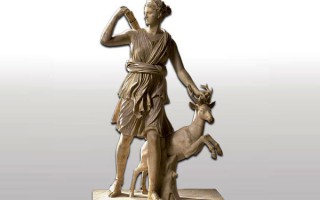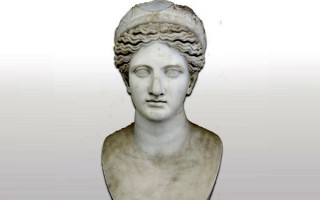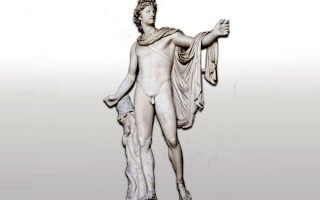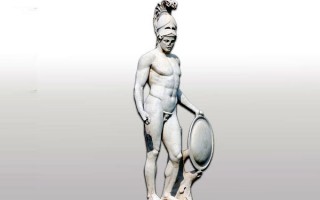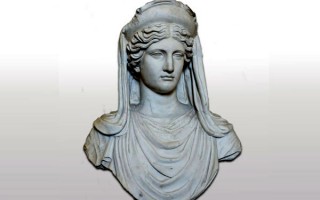- Home
- Post
- Twelve Olympus Gods +1
- Poseidon
Poseidon has been praised, by the Orphic poets, as “gaieochos” –he, who possesses the earth- and “kyanochaites” -he, who has an azure mane, thus possesses the sea. He was the god who “inhabited the foundations of the ocean” and would strike his trident, causing earthquakes and waves. He was the “stirrer of the earth” according to Homer.
Poseidon was the son of Kronos and Rhea and, together with others, the brother of Zeus. Whenever he was not on Olympus, he dwelt in his palace in the depths of the ocean, with his wife, the Nereid Amphitrite. One tradition says that he was raised in Rhodes, where he met Alia, sister of the Telchines, and had six sons and one daughter, called Rhode. The island of Rhodes had Rhode’s name. He was also the father of Theseus but also of Prokroustes, Skiron and the giants: the twins Otos and Ephialtes, Tityos and Orion. He had tamed the first horse (“hippos”) and was the father of winged Pegasus, from his union with Medusa.
His symbols were the fish and especially the dolphin and the “hippos” (horse), thus his epithet as “Hippios”. And, as Socrates says, in “Kratylos”, “Poseidon is posidesmos, since he ties up the feet of the mortals, depriving them of using their logic and forcing them to use their emotions which he controls”. “Hippodromies” (chariot races) would take place in all festivals in honor of the god, for whom the galloping horses shake the earth. Poseidon was the protector of the sailors to whom they sacrificed, before sailing or during the trip, for safe travelling.
Poseidon symbolizes the perpetual motion and the fluidness –just like the nature of the liquid element and, consequently, the world of emotions. Our emotions are never static, being always transformed according to the circumstances and the environment. There is a reason why the illnesses of the psyche were attributed to this great god who “moves” the human sentiments with his trident, just like the way he does it with the waves of the oceans.
According to Pausanias, Poseidon was one of the guardians of the oracle of Delphi, before Apollo. Apollo and Poseidon functioned side by side on many levels, i.e. colonization: the Delphian Apollo provided colonists with his “agreement”, while Poseidon provided them with his “purification water” for the sacrificial ceremony of their establishment in the newly founded colony. We find another connection between the two gods, In Xenophon’s “Anabasis”, a group of soldiers would sing a “paean” (400-399 BC), which was actually a hymn, sang for Apollo.
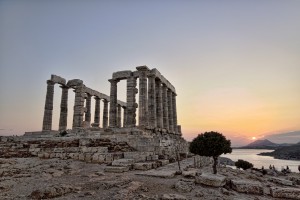 Sounion was an important “demos” (municipality) of the ancient city-state of Athens. The sanctuary of Poseidon occupies the top of the promontory of Sounion, offering views towards the Cyclades. The sanctity of the site is testified by Homer, since the 8th century BC. During the archaic age (7th-6th century BC) the sanctuary was already thriving, but its monumental formation was to come later, in the classical era.
Sounion was an important “demos” (municipality) of the ancient city-state of Athens. The sanctuary of Poseidon occupies the top of the promontory of Sounion, offering views towards the Cyclades. The sanctity of the site is testified by Homer, since the 8th century BC. During the archaic age (7th-6th century BC) the sanctuary was already thriving, but its monumental formation was to come later, in the classical era.During the excavations, a great quantity of dedications were discovered, buried in ancient “apothetes” (sacred dumping holes), which were gathered after the destruction of the sanctuary by the Persians, in 480 BC. The porous stone temple that was being built, during the Persian invasion, was destroyed as well. Years later, in 444 – 440 BC, a new temple was built whose ruins are still visible on the rock. It is a Doric temple, made of local marble from the near-by Agrileza rocks. The pediments were crowned by anthemia and, at least, the eastern one was decorated with statues. Its frieze was made of Parian marble and depicted scenes from the Centauromachy and the exploits of Theseus: an allegory of the victory of the Greeks against the Persians, in other words, an allegory of the supremacy of the Athenian Democracy versus the Persian despotism of the time. The temple is attributed to the same architect who designed the Hephaisteion of the Agora of Athens, the temple of Ares at Acharnes and the temple of Nemesis at Rhamnus.
A glorious festival was held in the sanctuary of Poseidon, every four years, during which the official guests sailed to Sounion, on the “Theoris” boat, just like they did to the sanctuary of Apollo on Delos. The whole temenos occupies an area of 5 acres. It was surrounded by a wall and was accessible through a monumental propylon, on its NE side. The temple stands out, on the southern side of the sanctuary, while, two stoas stand on the NW side of it.
The sanctuary of Poseidon thrived from the 5th century BC until the early Christian years, following the rise and decline of the ancient religion. Then, it was abandoned and, eventually, ruined. Today, the standing “kavokolones” (cape columns), on the top of the rock and seen from a distance, are still a symbol of the power of the god of the sea: Poseidon!
 Poros is a volcanic island, at the SW of the Saronic Gulf, by the SE coast of the Argolis peninsula. Due to geo-tectonic activities, Poros comprises of the main island, the so-called ancient “Kalavria” and a small, single volcanic rock, the so-called ancient “Sphairia”, separated from Kalavria, by a natural, narrow canal. As the myth determines, Kalavria, at first, was offered to god Apollo who made it over to god Poseidon, in return for Delphi. Kalavria was the ancient name of both the island and the main city. Such was the place’s importance, that it functioned as the center for the Amphictyonic League (“amphictionnes”: dwellers around), a “cooperative” of city-states, in both civic and religious matters, which included the ancient cities of Hermione, Epidauros, Aegina, Prassies, Athens and Arcadian Orhomenos.
Poros is a volcanic island, at the SW of the Saronic Gulf, by the SE coast of the Argolis peninsula. Due to geo-tectonic activities, Poros comprises of the main island, the so-called ancient “Kalavria” and a small, single volcanic rock, the so-called ancient “Sphairia”, separated from Kalavria, by a natural, narrow canal. As the myth determines, Kalavria, at first, was offered to god Apollo who made it over to god Poseidon, in return for Delphi. Kalavria was the ancient name of both the island and the main city. Such was the place’s importance, that it functioned as the center for the Amphictyonic League (“amphictionnes”: dwellers around), a “cooperative” of city-states, in both civic and religious matters, which included the ancient cities of Hermione, Epidauros, Aegina, Prassies, Athens and Arcadian Orhomenos.Poseidon’s sanctuary was built on a height of 190 meters above the sea, near the ancient city. The sanctuary was a prestigious center of Panhellenic worship and, being the seat of the Amphiktyone of Kalavreia, served as an “asylum”. It was here where the famous orator Demosthenes retreated and died in 322 BC (Strabo 8.6.14). This large temenos (cult place) has yielded material remains of long-lived and multi-faceted cult activity, from possibly prehistoric to late antique date. The Doric temple was built in 520 BC (end of archaic age). The sanctuary was extended towards the south, in the end of the 4th century BC, with the construction of buildings C, D and the propylaea. Its use continued till the late roman years.
The area was excavated by the Swedish archaeologists Samuel Wide and Lennart Kjellberg in 1894 – the first Swedish excavation in Greece. In their early publication (Athenische Mitteilungen 1895), they focus on the dating of the architectural ruins. The richness of the Mycenaean pottery, found inside the temple, led them to the belief that the establishment of the Amphictyonic League took place in the 2nd millenium BC. This is a theory that has been under question. New excavations started in 1997 by the Swedish Institute of Athens.
 The archaeological site is located 4 kilometers west of Kalamata and 500 meters south of modern Akovitika. It comprises of two excavated areas, 200 meters apart from each other, both by the banks of Aris River.
The archaeological site is located 4 kilometers west of Kalamata and 500 meters south of modern Akovitika. It comprises of two excavated areas, 200 meters apart from each other, both by the banks of Aris River.The ruins were revealed in 1968, during flood prevention works, at the banks of the river and during the excavations of the following years. They belong to two groups: the first group comprises of two large, early Helladic buildings of the “megaron” type (3rd millenium BC) and the second group belongs to the buildings of the sanctuary of Poseidon, 200 meters further to the south.
In the sanctuary of Poseidon, archaeologists have dug up the northern side of a rectangular structure, with an inner atrium and an exterior Doric-columned arcade that surrounds the building. A long, narrow corridor, with wooden columns, enclosed the arcades from the exterior. A small well, made of limestone, was found in the interior. The building must have been roofed by tiles of the “laconic” type, with the sign ΔΑΜΟΣΙΟΣ (DAMOSIOS), which means “public”, indicating the character of the building. The building is dated from the 6th century BC, but there is evidence of an earlier phase of construction (late 7th century BC). Among the finds, iron models of equipment from boats and ships, as well as a bronze fish hook, have led scientists to believe that the sanctuary was built by sailors as tribute to the god of the sea, Poseidon, a fact confirmed by an inscription written on the body of a clay vessel.
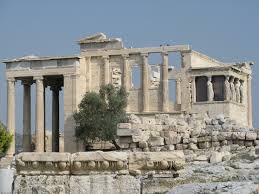 The elegant building known as the Erechtheion, on the north side of the sacred rock of the Acropolis, was erected in the classical age (421-406 BC) as a replacement of the earlier “old temple” which was dedicated to Athena “Polias” (goddess of the “polis” or city).
The elegant building known as the Erechtheion, on the north side of the sacred rock of the Acropolis, was erected in the classical age (421-406 BC) as a replacement of the earlier “old temple” which was dedicated to Athena “Polias” (goddess of the “polis” or city).The name ”Erechtheion”, mentioned only by Pausanias (1.26.5), derives from Erechtheus, a mythical king of Athens, who was worshipped after his death as a hero-ancestor. Other texts refer to the building simply as ”old temple”. The building owes its unusual shape to the irregularity of the terrain – there is a 3-meter difference, in height, between the eastern and western parts- and the multiple cults it was designed to accommodate. The eastern part of the building was dedicated to Athena “Polias”, while the western part served the cult of Poseidon-Erechtheus and also held the altars of god Hephaestus and Voutos, brother of Erechtheus. Added to these, the Erechtheion was the dwelling place of goddess Athena’s sacred snake, the so-called “Erichthonios” and the shelter for the grave of Kekrops, the first heroic king of the city. When the monument was being built, the architects took care not to “disrupt” the holy traces of the dispute between Athena and Poseidon for the patronage of the city.
The temple was made of Pentelic marble, the frieze of Eleusinian grey stone with white relief figures attached to it and the foundations of Piraeus stone. On its eastern side, an Ionic portico with six columns sheltered the eastern entrance of the building. The cult statue of Athena stood in the interior, made of olive wood, which the “Arrhephoroi” (young Athenian priestesses) draped with the sacred peplos, during the Panathenaic festival. On the northern side, one can see the entrance to the western part of the building, sheltered by a Greek pi-shaped propylon, with four Ionic columns along the facade and one, on either side. The stone paving of this propylon was thought to preserve the traces made by Poseidon’s trident, when it hit the ground and brought sea water to the surface. Under the temple’s floor and according to tradition, there was ”Erechtheis Sea” where Poseidon’s sea waters gathered. A small door on the western side led to the near-by sanctuary of Pandrosos (king Kekrops’ daughter). Four Ionic columns on a high stylobate, with metal railings between them, adorned the west facade. Finally, another door on the southern facade of the western temple opened onto the porch of the Karyatides, a Greek pi-shaped structure, a kind of veranda porch with six female statues, supporting the roof, instead of columns. They were created by Alkamemes or Kallimachos and were called, initially, “korae”. Later, in the roman era, they called them “Karyatides”, after the young women from Karyes of Lakonia, who were renowned for their beauty and used to dance in honour of the goddess Artemis. Five of them are in the Acropolis Museum and the sixth in the British Museum, thus the ones standing in situ, today, are old casts.
The temple was burned in the 1st century BC and was, subsequently, repaired with minor alterations. In the Early Christian period it was converted into a church dedicated to the “Theometor” (Mother of God). It was converted into a palace, during the Frankish rule and, later, into a residence for the Turkish commander’s harem, during the Ottoman occupation. In the early 19th century, Lord Elgin removed one of the Karyatides and a column and during the Greek War of Independence the building was bombarded and severely damaged. Restoration was undertaken immediately after the end of the war and again in 1979-1987, when the Erechtheion became the first monument of the Acropolis to be restored, as part of the recent conservation and restoration project. Its restoration received the Europa Nostra award.
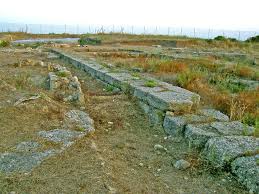 Poseidi is a summer resort at the promontory of the peninsula of Cassandra, in Chalkidiki. In the near-by area, traces of ancient Mendi, an Eretrian colony of the 8th century BC, have been found. The ancient city was well known for the production of the famous “mendian” wine.
Poseidi is a summer resort at the promontory of the peninsula of Cassandra, in Chalkidiki. In the near-by area, traces of ancient Mendi, an Eretrian colony of the 8th century BC, have been found. The ancient city was well known for the production of the famous “mendian” wine.Not far from the ruins of the Mendi, at Poseidi, an important sanctuary of Poseidon was excavated, comprising of a classical temple (5th century BC), two buildings (7th-6th century BC), on both sides of it and an early-geometric apsidal building (11th century BC), which is the oldest. All buildings were sacred, bearing altars for sacrifices and sacred spaces for ceremonies. The sanctuary operated for more than 1000 years, and there are references about it in Thucydides and in Mount Athos documents of the 14th century. Probably it was built by the Eretrian colonists, who stayed at ancient Mendi and worshipped Poseidon as their protector.
The lighthouse, which is still standing at the edge of the promontory, was built in 1864 (19th century).
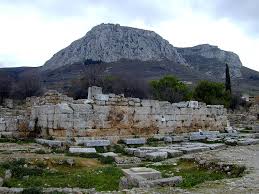 At Isthmia, northeast from ancient Corinth and very close to the isthmus, connecting the mainland of Greece with the Peloponnese, there stand the ruins of the sanctuary of Poseidon. The Sanctuary became a major extramural shrine of the Corinthians, their most important religious foundation outside the city. It was one of four sanctuaries where Greeks from all parts of the Mediterranean came to compete in Pan-Hellenic games.
At Isthmia, northeast from ancient Corinth and very close to the isthmus, connecting the mainland of Greece with the Peloponnese, there stand the ruins of the sanctuary of Poseidon. The Sanctuary became a major extramural shrine of the Corinthians, their most important religious foundation outside the city. It was one of four sanctuaries where Greeks from all parts of the Mediterranean came to compete in Pan-Hellenic games.The first traces of the temple are dated from the 7th century BC and belong to the tiles of its roof and to a marble “perirrhanterion” (fount). In the 5th century BC (470 – 460 BC) the whole area of Isthmia was destroyed by fire and a new temple is rebuilt, as a Doric “peripteral” (with a surrounding colonnade) from local limestone. The “pteron” (colonnade) had 6×13 columns and a “stylobate” of 54×23 meters. It had marble tiles with beautiful marble spouts in the form of lion heads. Another fire, in the spring of 390 BC, destroyed the sanctuary, during the war between the king of Sparta Agesilaus and the troops of the Corinthians. The temple was restored and the marble tiles were replaced by ceramic ones. The sanctuary continued thriving till the destruction of Corinth by the roman troops of Mommius, in 146 BC. After the establishment of the roman colony, over the ruins of the ancient city, by Julius Caesar and during the reign of Tiberius, the sanctuary of Poseidon was totally rebuilt.
After its last destruction by an earthquake (4th century AD) and the decrees against the use of ancient temples issued by emperors Theodosius A’, Arcadius and Theodosius B’, the temple of Poseidon was abandoned. Eventually, the ruins of the sanctuary became a quarry of ready-made blocks of building material. It was actually reused by the general of Justinian’s army, Victorinos, who was in charge of the construction of a fortification wall, across the isthmus, the so-called “hexamillion”. Such walls and fortresses, all around Greece, were part of the great-scale defensive project of emperor Justinian, across the Byzantine Empire.
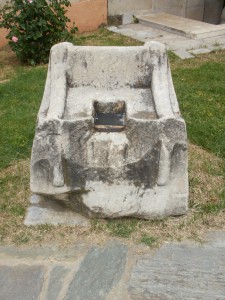 The sanctuary of “Hippios” Poseidon, in ancient Mantineia, was of great importance for the Arcadians, who worshipped Poseidon as one of their great gods. Most of the epithets of the god describe his impetus. They called him “Holetera” (he, who blends), “Mochlotera” (he, who prizes) and “Hippio” (horse-like). Being the god of the earthquakes and waters, he is connected with the proud horses, sensitive in under-earth currents and powers.
The sanctuary of “Hippios” Poseidon, in ancient Mantineia, was of great importance for the Arcadians, who worshipped Poseidon as one of their great gods. Most of the epithets of the god describe his impetus. They called him “Holetera” (he, who blends), “Mochlotera” (he, who prizes) and “Hippio” (horse-like). Being the god of the earthquakes and waters, he is connected with the proud horses, sensitive in under-earth currents and powers.The sanctuary is located on the SE of the ancient city of Mantineia, next to Arne spring, where the god was born. The temple of the sanctuary was an Abaton. Once a year, the priest who served in the sanctuary, would perform the mystic rites in honor of Poseidon, away from the eyes of the people. The temple was built by the Boeotian architects, Trofonios and Agamedes, who had the fame of building temples only for the immortals. It was ruined during the roman times, so Emperor Hadrian who visited Mantineia, in 130 AD, decided to restore it.
The ruins of the sanctuary were discovered by the French archaeologist Fougeres, who worked in the Arcadian land, followed by the Greek archaeologist Spyropoulos. Today, among the ruins, one can see the foundations of the temple, a group of sacred chambers and bases of pillars. A Byzantine cist grave indicates the use of the area by a local landholder. Additionally, an ancient aqueduct and lots of inscriptions were brought to light.
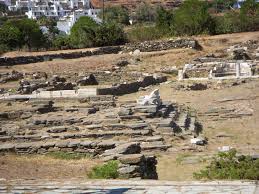 Kionia houses one of the most important sanctuaries of Poseidon on the Cyclades. It was a sanctuary, tightly connected with life in the ancient city of Tinos, from the 4th century BC onwards. In fact, Tinos was the only island of the Cyclades that has dedicated an entire sanctuary to Poseidon only. Along with him, his wife, the sea nymph Amphitrite, was also worshiped. God Poseidon, being the god of purifying and healing water, was worshipped as a doctor as well. Specifically, during the Hellenistic years, a burst of the cult of hero-doctors is observed.
Kionia houses one of the most important sanctuaries of Poseidon on the Cyclades. It was a sanctuary, tightly connected with life in the ancient city of Tinos, from the 4th century BC onwards. In fact, Tinos was the only island of the Cyclades that has dedicated an entire sanctuary to Poseidon only. Along with him, his wife, the sea nymph Amphitrite, was also worshiped. God Poseidon, being the god of purifying and healing water, was worshipped as a doctor as well. Specifically, during the Hellenistic years, a burst of the cult of hero-doctors is observed.Towards the end of the 4th century BC, the heirs of Alexander the Great, and especially the Macedonian royal houses of the Antigonidae and the Lagidae, hold the fate of the Cyclades in their hands and organize building programs. This is testified by the emblematic Macedonian star which decorates the ceiling panels of the fountain of the sanctuary.
The 4th century BC is the age when the ancient city appears on the site of the modern town of Tinos, simultaneously with the first monumental buildings in the sanctuary, at modern near-by Kionia. Kionia was a kind of relief anchorage for sailors, who stopped there, when, on their way to sacred Delos, in order to offer sacrifices to the god of the sea for safe travelling through the rough waves of the pass between the two islands. The huge cult statues of Poseidon and Amphitrite were kept inside the temple. On a yearly basis, between January and February, religious ceremonies known as “Poseidonia” were celebrated in honour of the god. The festival attracted people from all around Greece, where they would attend theatrical contests and participate in sacred rites and sacrifices. The cult of Amphitrite was established at the same period. She was worshipped for her healing powers to women who could not have children. The sanctuary had the same fame with the Asclepion of Epidaurus and was regularly visited by hundreds of people. The natural environment contributed to this fame since the sanctuary was built in a peaceful, idyllic grove, by the sea.
The Doric temple and the other buildings of the sanctuary were embellished by some local inspired works, like the fountain-exedra. Local marble and gneiss stones have been used, in a variety of colors. Famous ancient sculptors were invited to work on the project like the Athenian Telesinus, the Ephesian Agasias and the Macedonian Andronikos who constructed the famous sun clock which is displayed in the Archaeological Museum of the island.
When Delos became a free port, in the end of the 2nd century BC, the sanctuary at Kionia was restored, acquiring a great stoa and a monumental altar. The temple was so famous that Strabo (1st century AD) describes it as “great and worth seeing”. It had become known in Italy and Asia Minor. The decline comes, gradually, from the roman times till the 3rd century AD, when the sanctuary is abandoned. A kiln operates over the ruins which had been transformed into a quarry of building material. In the 4th century A.D, when Christianity was established as a religion, the temple was destroyed.
Kionia area was first excavated in 1902 and 1905 by the Belgian archaeologists H. Demoulin and P. Graindor respectively. Apart from the main temple, the archaeological site includes baths, an altar, a monumental stoa and a fountain. Some of the finds of the excavations are displayed in the Archaeological Museum of Tinos.


